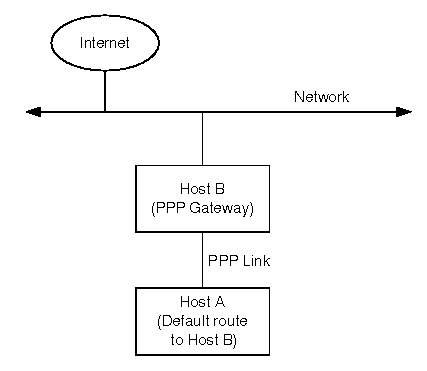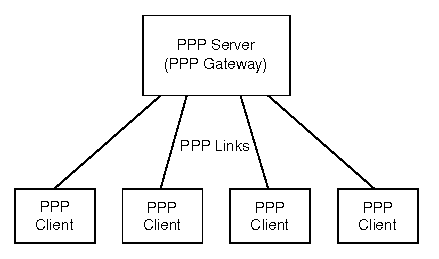Complex PPP connection scenarios
Many networking scenarios use PPP to connect
two hosts via modems or a dedicated serial line.
While these scenarios may require some effort to
achieve a successful connection, they are simple in that they
only involve configuration of one connection.
This section provides a description of two more complex
scenarios that require multiple connections,
including one or more PPP links,
to resolve the scenario's networking needs.
PPP gateway scenario
The first complex connection scenario is illustrated by
``PPP gateway scenario''.

PPP gateway scenario
The requirements of this scenario are that host A needs to access the
Internet but has no direct access. To gain Internet access, host A
must use PPP to connect to host B, which does have Internet access.
Host B must act as a gateway to the Internet for host A.
This scenario requires that:
PPP server scenario
The second complex connection scenario is illustrated by
``PPP server scenario''.

PPP server scenario
The requirements of this scenario are for a single host to act
as a PPP server.
Multiple hosts connect to this server using PPP, and the server
provides services (such as Internet access) to these hosts
over the PPP connections.
There are two special configuration issues for a PPP server:
-
the PPP server must be configured as a PPP gateway (see
``PPP gateway'').
-
the PPP server must be represented by a unique IP address
to each client.
A configuration decision is whether this address
(and the unique IP address by which the server will
know the client) will be
assigned by the server or by each client.
NOTE:
The following configuration requirements apply only to
the server configuration.
Since the clients may be running a non-SCO PPP implementation,
no assumptions are made about the clients' configurations.
If the server assigns addresses, this requires the
following server configuration:
-
The server must have an incoming remote access configuration
in its /etc/ppphosts file
for each client from which it will accept a PPP link request.
NOTE:
For servers that assign IP addresses from an IP
address pool, it is possible to have more than one client log in using the same
login accounts. This makes configuration simpler by requiring
fewer PPP client accounts on the server.
-
The server must specify unique local and remote IP addresses in each
client entry.
These addresses may be specified at configuration
time for each entry, or a pool of IP addresses may be created
from which PPP chooses when the link is brought up.
For more information on how to implement this choice, see
``Configuring an endpoint for remote access''.
-
Each client host must agree to use the remote and local IP
addresses that the PPP server specifies for that client.
If the clients assign addresses,
this requires the following configuration:
-
The remote access endpoints configured on the server
that will be used by the clients
must permit IP address negotiation.
That is, they must not specify
the noipaddr configuration parameter.
-
The remote access endpoints configured on the server
that will be used by the clients
must not specify
local or remote IP addresses.
-
Each client must specify unique remote and local IP addresses
when negotiating for a PPP link with the server.
-
Each client must support IP
address negotiation with the server.
NOTE:
It is possible for two or more clients to log in using
the same login account.
This makes configuration simpler by requiring fewer PPP
login accounts.
Next topic:
PPP MIB support
Previous topic:
Proxy ARP example
© 2003 Caldera International, Inc. All rights reserved.
SCO OpenServer Release 5.0.7 -- 11 February 2003


